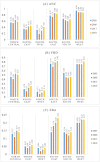Geographical and socioeconomic inequalities in the utilization of maternal healthcare services in Nigeria: 2003-2017
- PMID: 32912213
- PMCID: PMC7488161
- DOI: 10.1186/s12913-020-05700-w
Geographical and socioeconomic inequalities in the utilization of maternal healthcare services in Nigeria: 2003-2017
Abstract
Background: Maternal mortality has remained a challenge in many low-income countries, especially in Africa and in Nigeria in particular. This study examines the geographical and socioeconomic inequalities in maternal healthcare utilization in Nigeria over the period between 2003 and 2017.
Methods: The study used four rounds of Nigeria Demographic Health Surveys (DHS, 2003, 2008, 2013, and 2018) for women aged 15-49 years old. The rate ratios and differences (RR and RD) were used to measure differences between urban and rural areas in terms of the utilization of the three maternal healthcare services including antenatal care (ANC), facility-based delivery (FBD), and skilled-birth attendance (SBA). The Theil index (T), between-group variance (BGV) were used to measure relative and absolute inequalities in the utilization of maternal healthcare across the six geopolitical zones in Nigeria. The relative and absolute concentration index (RC and AC) were used to measure education-and wealth-related inequalities in the utilization of maternal healthcare services.
Results: The RD shows that the gap in the utilization of FBD between urban and rural areas significantly increased by 0.3% per year over the study period. The Theil index suggests a decline in relative inequalities in ANC and FBD across the six geopolitical zones by 7, and 1.8% per year, respectively. The BGV results do not suggest any changes in absolute inequalities in ANC, FBD, and SBA utilization across the geopolitical zones over time. The results of the RC and the AC suggest a persistently higher concentration of maternal healthcare use among well-educated and wealthier mothers in Nigeria over the study period.
Conclusion: We found that the utilization of maternal healthcare is lower among poorer and less-educated women, as well as those living in rural areas and North West and North East geopolitical zones. Thus, the focus should be on implementing strategies that increase the uptake of maternal healthcare services among these groups.
Keywords: Geographical inequalities; socioeconomic inequalities; Maternal healthcare; Nigeria.
Conflict of interest statement
There is no conflict of interest.
Figures


Similar articles
-
Social inequalities in the utilization of maternal care in Bangladesh: Have they widened or narrowed in recent years?Int J Equity Health. 2014 Dec 10;13:120. doi: 10.1186/s12939-014-0120-4. Int J Equity Health. 2014. PMID: 25492512 Free PMC article.
-
Socioeconomic inequalities in maternal health service utilisation: a case of antenatal care in Nigeria using a decomposition approach.BMC Public Health. 2019 Nov 8;19(1):1493. doi: 10.1186/s12889-019-7840-8. BMC Public Health. 2019. PMID: 31703734 Free PMC article.
-
Socioeconomic inequalities and determinants of maternal health services in Shaanxi Province, Western China.PLoS One. 2018 Sep 5;13(9):e0202129. doi: 10.1371/journal.pone.0202129. eCollection 2018. PLoS One. 2018. PMID: 30183720 Free PMC article.
-
Inequity in uptake of maternal health care services in developing countries: a systematic review and meta-analysis.Front Public Health. 2024 Jun 26;12:1415092. doi: 10.3389/fpubh.2024.1415092. eCollection 2024. Front Public Health. 2024. PMID: 38989116 Free PMC article.
-
Inequities in utilization of reproductive and maternal health services in Ethiopia.Int J Equity Health. 2017 Jun 19;16(1):105. doi: 10.1186/s12939-017-0602-2. Int J Equity Health. 2017. PMID: 28629358 Free PMC article. Review.
Cited by
-
Estimates and determinants of health facility delivery in the Birhan cohort in Ethiopia.PLoS One. 2024 Jul 26;19(7):e0306581. doi: 10.1371/journal.pone.0306581. eCollection 2024. PLoS One. 2024. PMID: 39058714 Free PMC article.
-
PUERPERAL SEPSIS AT UNIVERSITY COLLEGE HOSPITAL, IBADAN: A 10-YEAR REVIEW.Ann Ib Postgrad Med. 2022 Jun;20(1):32-39. Ann Ib Postgrad Med. 2022. PMID: 37006644 Free PMC article.
-
Inequality in Utilization of Maternal Healthcare Services in Low‑ and Middle‑Income Countries: A Scoping Review of the Literature.Matern Child Health J. 2025 Jun;29(6):741-766. doi: 10.1007/s10995-025-04111-9. Epub 2025 Jun 3. Matern Child Health J. 2025. PMID: 40461773 Free PMC article.
-
Prognostic factors of time to first abortion after sexual debut among fragile state Congolese women: a survival analysis.BMC Public Health. 2021 Mar 17;21(1):525. doi: 10.1186/s12889-021-10599-x. BMC Public Health. 2021. PMID: 33731079 Free PMC article.
-
Decomposition of socioeconomic inequalities in the uptake of intermittent preventive treatment of malaria in pregnancy in Nigeria: evidence from Demographic Health Survey.Malar J. 2021 Jul 3;20(1):300. doi: 10.1186/s12936-021-03834-8. Malar J. 2021. PMID: 34217299 Free PMC article.
References
-
- Jayasundara DS, Panchanadeswaran S. Maternal mortality in developing countries: applicability of Amartya Sen's theoretical perspectives. J Comp Soc Welfare. 2011;27(3):221–231.
-
- Shabnam J, Gifford M, Dalal K. Socioeconomic inequalities in the use of delivery care services in Bangladesh: a comparative study between 2004 and 2007. Health. 2011;03(12):762–771.
-
- Ononokpono DN, Odimegwu CO, Imasiku E, Adedini S. Contextual determinants of maternal health care service utilization in Nigeria. Women Health. 2013;53(7):647–668. - PubMed
-
- Obiyan MO, Kumar A. Socioeconomic Inequalities in the Use of Maternal Health Care Services in Nigeria. SAGE Open. 2015;5(4):1–11.
MeSH terms
LinkOut - more resources
Full Text Sources
Medical
Miscellaneous

